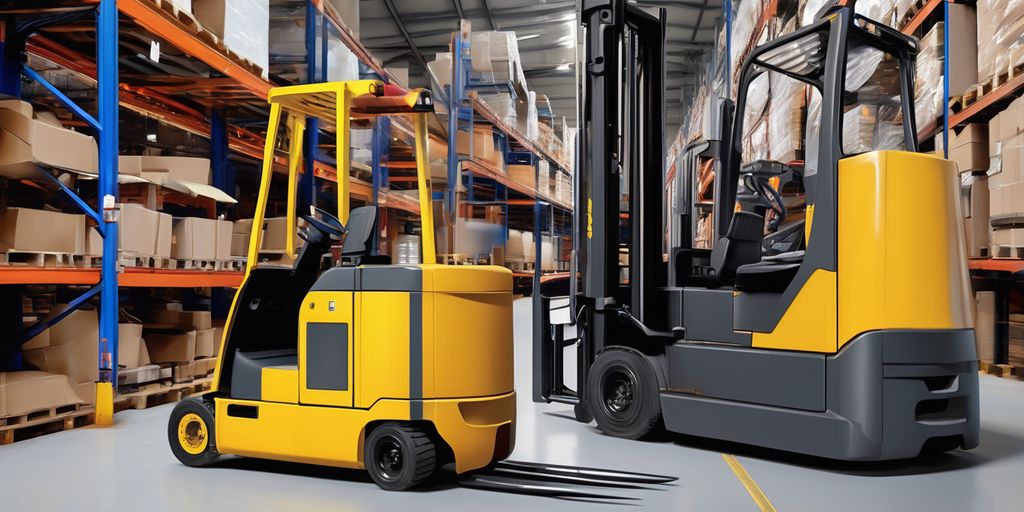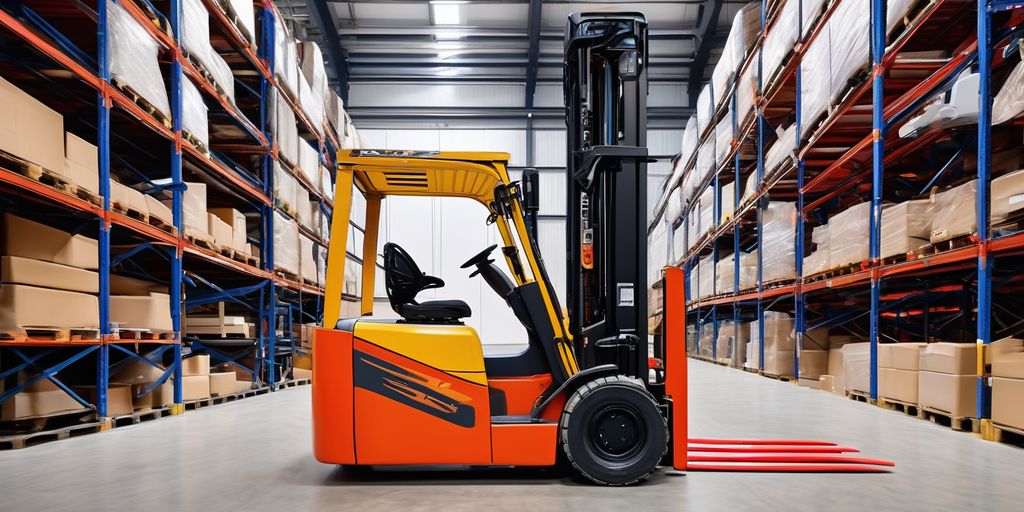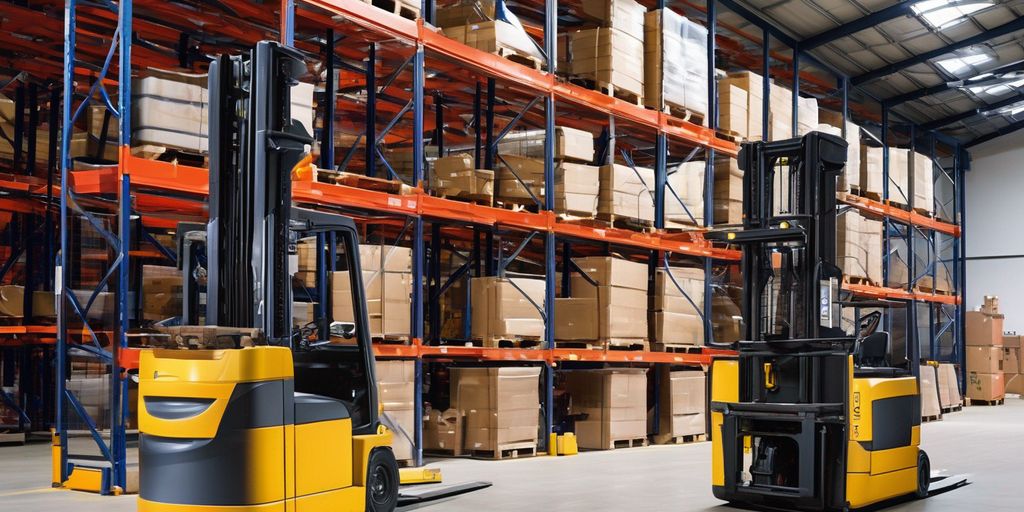Forklifts are indispensable in numerous industries, aiding in the efficient movement and transportation of heavy loads. To ensure the optimal performance and safety of these machines, understanding forklift parts and functionalities is crucial. In this comprehensive guide, we’ll navigate the world of forklifts by exploring the essential parts that make these powerful machines work seamlessly.
Key Takeaways
- Understanding the power source of a forklift, whether electric or internal combustion, is vital for efficient operation and maintenance.
- The mast is the backbone of the forklift, and knowing its types and functions can help in selecting the right forklift for specific tasks.
- Proper maintenance and understanding of forks and attachments can greatly enhance the versatility and safety of forklift operations.
- The counterweight is crucial for the stability of the forklift, and its proper use and maintenance are essential for safe operation.
- A well-maintained hydraulic system ensures smooth and efficient movement, making it important to understand its components and troubleshooting techniques.
The Power Source: Fueling Your Fork Truck
Understanding the power source of your fork truck is crucial for optimal performance and efficiency. Forklifts can be powered by various sources, including electricity (battery-powered), gasoline, diesel, or propane. Each of these options has distinct advantages and disadvantages, which we'll explore in this section.
The Mast: Backbone of the Fork Truck
The mast is the vertical assembly responsible for raising and lowering the forks. It consists of channels, rails, and interlocking rails that guide the lift carriage during operation. The forklift mast and engine are the backbone of any forklift truck, providing the necessary support and movement for handling loads efficiently.
Types of Masts: Standard, Duplex, Triplex
Forklift masts come in various types, each designed for specific applications and lift heights. The most common types include:
- Standard Mast: A single-stage mast suitable for basic lifting tasks.
- Duplex Mast: A two-stage mast that offers greater lift heights and is ideal for warehouses with higher storage racks.
- Triplex Mast: A three-stage mast providing maximum lift height and versatility, often used in high-density storage environments.
Mast Operation and Safety
Operating the mast requires careful attention to safety protocols. The lift cylinder controls the vertical movement of the mast and forks, ensuring smooth and precise lifting. Operators must be trained to handle the mast correctly to avoid accidents and ensure efficient operation.
Regular maintenance and safety measures are necessary to ensure the mast’s safe and efficient operation.
Common Issues and Troubleshooting
Common issues with forklift masts include hydraulic leaks, misalignment of the rails, and wear and tear on the lift cylinder. Troubleshooting these issues involves:
- Inspecting the hydraulic system for leaks and ensuring proper fluid levels.
- Checking the alignment of the mast rails and adjusting as needed.
- Replacing worn or damaged components to maintain optimal performance.
By understanding the forklift mast’s function and construction, operators can ensure that their forklifts are operating at peak performance.
Forks and Attachments: Versatility in Handling Loads

Fork trucks are indispensable in material handling and warehouse operations, but their efficiency can be significantly enhanced with the right attachments. Choosing the right forks and attachments can make a substantial difference in productivity and safety.
There's a forklift attachment for almost any task from self-dump hoppers and buckets, wire mesh handlers, heavy-duty spreader bars, work platforms, lift hooks, and more.
Standard Forks vs. Specialized Attachments
Forks, the prongs that slide under a load to lift it, come in various sizes and configurations to accommodate different lifting needs, such as entirely tapered, tire, tin plate, and spark-resistant forks. Forklift attachments, such as side shifters, fork positioners, rotators, and clamps, can be added to handle loads of varying sizes and shapes or perform specific tasks like turning bins or lifting personnel.
Attachment Installation and Safety
- Ensure the forklift is turned off and the parking brake is engaged.
- Attach the new equipment securely, following the manufacturer's guidelines.
- Test the attachment without a load to ensure proper installation.
- Train operators on the specific use and safety considerations of the new attachment.
Choosing the Right Forks for Your Needs
When selecting forks and attachments, consider the following:
- Load Type: Different attachments are designed for specific load types, such as barrels, drums, or paper rolls.
- Load Size: Ensure the forks or attachments can handle the dimensions and weight of your typical loads.
- Operational Environment: Some attachments are better suited for indoor use, while others are designed for outdoor conditions.
- Frequency of Use: High-frequency tasks may require more durable or specialized attachments.
By understanding and utilizing the appropriate forks and attachments, you can maximize efficiency and safety in your operations.
The Counterweight: Ensuring Stability
The counterweight is a critical component of a forklift, designed to balance the weight of the load being lifted. This balance is essential for maintaining stability and safety during operation. The stability triangle is the area within which the forklift must remain while in motion to prevent tip-overs or dropped loads.
Function of the Counterweight
The counterweight is typically located at the rear of the forklift, opposite the lift fork. On some electric-powered forklifts, the battery may serve as the counterweight. In internal combustion forklifts, the counterweight is usually found at the center of the rear axle. This placement helps keep the forklift stable on its three balance points as it lifts and maneuvers with heavy loads.
Types of Counterweights
Counterweights can vary depending on the type of forklift. For example, electric forklifts may use the battery as a counterweight, while internal combustion forklifts have a dedicated counterweight made of heavy materials like cast iron or steel. The choice of counterweight affects the forklift's maximum lift capacity, so it's important to check the maximum carrying capacity to ensure it's appropriate for the job.
Safety Considerations
A safe forklift operation requires a thorough understanding of the significance of the counterweight and the stability triangle. Operators must always be mindful of these factors to navigate the forklift securely within the stability triangle and minimize the risk of tip-overs or dropped loads. Regular checks and maintenance of the counterweight are also crucial to ensure it remains effective in balancing the load.
Among forklift parts, the counterweight is absolutely crucial to maintaining the proper balance.
The Hydraulic System: Powering Movement
The hydraulic system is a critical component of a fork truck, responsible for its lifting and tilting functions. When the operator activates the controls, hydraulic fluid is pressurized, creating the force necessary to lift the forks and the load. By controlling the flow of hydraulic fluid, the operator can precisely maneuver the forklift and position the load.
Components of the Hydraulic System
Hydraulic components, such as cylinders, pumps, hoses, and valves, are responsible for the lifting capabilities and stability of forklifts. Proper maintenance and timely replacement of hydraulic parts are crucial for smooth lifting operations, load stability, and overall performance. Regular inspection and adherence to manufacturer's guidelines are vital for efficient hydraulic system maintenance.
Hydraulic Fluid: Types and Maintenance
Hydraulic fluid is the lifeblood of the hydraulic system. There are various types of hydraulic fluids, each with specific properties and applications. Regularly checking the fluid levels and ensuring there are no leaks is essential. Using the correct type of hydraulic fluid can significantly impact the performance and longevity of the hydraulic system.
Troubleshooting Hydraulic Issues
Common hydraulic issues include leaks, unusual noises, and slow operation. Identifying the root cause of these problems often involves inspecting the hydraulic components and fluid. Timely troubleshooting and repairs can prevent more severe damage and ensure the forklift operates efficiently.
Maximizing efficiency with the right fork truck attachments can enhance productivity, cost savings, and worker safety in material handling.
Operator's Cabin: Control and Comfort
The operator's cabin is the space within the frame where the operator sits. It contains the operator seat and forklift controls used to maneuver the vehicle and components, including the vertical control for the mast and forks. Safety first: best practices for operating a forklift include understanding controls, safe load handling, clear visibility, pedestrian safety, and maintenance procedures.
Wheels and Tires: Ground Contact and Mobility
Types of Forklift Tires
Forklift tires come in various types, each suited for different applications. The most common types include pneumatic, solid, and polyurethane tires. Pneumatic tires are filled with air and provide a cushioned ride, making them ideal for outdoor use on rough terrain. Solid tires, on the other hand, are puncture-proof and require less maintenance, making them suitable for indoor use. Polyurethane tires are lightweight and offer excellent traction, often used in warehousing and manufacturing environments.
Tire Maintenance and Replacement
Proper tire maintenance is crucial for the safe and efficient operation of your forklift. Regularly inspect tires for wear and tear, and ensure they are inflated to the correct pressure. When it's time for a replacement, start by using a hydraulic jack to lift the vehicle off its wheels. This step marks the beginning of changing tires on a forklift truck. One needs to place their jack securely to avoid accidents. Always follow the manufacturer's guidelines for tire replacement to ensure safety and longevity.
Impact of Tires on Performance
The type and condition of your forklift tires significantly impact the machine's performance. Worn-out or improperly inflated tires can lead to reduced stability and increased fuel consumption. You can increase the stability of your forklift by lifting your load no more than 6 inches from the ground, avoiding sudden accelerations or stops, and carrying loads close to the ground. Proper tire selection and maintenance not only enhance performance but also contribute to the overall safety of the operation.
Ensuring your forklift is equipped with the right type of tires and maintaining them properly can lead to significant improvements in both safety and efficiency.
Conclusion
In conclusion, understanding the essential components and functions of a forklift, practicing safe operation and handling techniques, and adhering to proper maintenance and servicing guidelines are all crucial to ensuring the safety and efficiency of forklift operation. With the knowledge provided in this comprehensive guide, forklift operators can confidently navigate the world of forklifts and contribute to a safer, more productive workplace.
Frequently Asked Questions
What are the main types of power sources for forklifts?
Forklifts primarily use electric batteries or internal combustion engines (powered by diesel, gasoline, or propane) as their power sources.
How often should I perform maintenance on a forklift's battery?
Regular maintenance, including checking water levels and cleaning terminals, should be performed on a forklift's battery at least once a week.
What is the function of the counterweight in a forklift?
The counterweight is essential for balancing the forklift, providing stability, and preventing it from tipping over when lifting heavy loads.
How do I choose the right type of mast for my forklift?
Choosing the right mast depends on your specific needs, such as lift height requirements and the type of loads you handle. Common types include standard, duplex, and triplex masts.
What safety features should I look for in an operator's cabin?
Key safety features include ergonomic design, clear control systems and displays, seat belts, and overhead guards to protect the operator.
How can I troubleshoot common hydraulic system issues in a forklift?
Common hydraulic issues can often be resolved by checking for leaks, ensuring proper fluid levels, and inspecting hoses and connections for damage.




Leave a comment
This site is protected by hCaptcha and the hCaptcha Privacy Policy and Terms of Service apply.